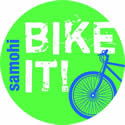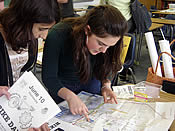
Founded in 2004, the Samohi Solar Alliance (SSA) is a student-run, grassroots organization working to inspire environmental awareness, education, and tangible change at Santa Monica High School (Samohi) and in the greater community. SSA unites passionate students, faculty, alumni, parents, and community members to create a healthier planet through structural and behavioral change on a local level. Its initiatives are fueled by the power and engagement of youth.
Recently, WKCD spoke with Lulu Mickelson, Samohi senior and co-president of SSA, about the Alliance’s many accomplishments, including the “Bike It” initiative.
Our first project, the initial reason SSA was created, was to solarize the school’s swimming pool. After developing a game plan with the district, we helped raise the money for the initial testing of the roof and then we tapped into funds the district had allocated for structural redevelopment to cover the cost of the panels. Now, with the panels on, we save $22,000 a year in heating costs and a similar number of therms, a single therm is the energy equivalent to burning 100 cubic feet of natural gas. Getting the panels up and running was very exciting, because the pool was the biggest contributor to our school’s carbon footprint. It’s an Olympic size pool, so the impact of not having to heat all the water is substantial.
At the tail end of this initiative, in 2006, the voters of Santa Monica approved a bond measure to support the remodeling of multiple campuses in the district, including the high school. SSA worked to included a provision in the legislation that all changes would have to be made with sustainability and efficiency in mind. Now, every redone building is being brought up to CHPS standards (the Collaborative for High Performance Schools), which is like LEED certification for educational institutions. Members of SSA sit on the board that oversees the project.
With these structural victories, we decided to rethink what we were doing as a club, to move beyond solar panels and buildings. What do we do now? What’s next?
We decided to turn toward student behaviors that affect the school’s carbon footprint. That’s how we settled on transportation. We realized that reducing the CO2 that was emitted from the cars that brought 3,050 students to and from school each day would be one of the easiest and most substantial ways we could make change, through behavioral shifts on campus.
Bike It
We started “Bike Day,” which has now escalated into the “Bike It” initiative. We’re trying to convince students to get to school without a car. Three to five days a year, we organize events that challenge students to find a new way to get to school, any way, that doesn’t involve a car—walking, biking, skateboarding, taking the bus. We do it on a day when there’s staff development and school starts a little later, so there’s no whining about having to get up earlier. It has become a big celebratory event on campus, everyone knows about it, everyone wants to participate. Students and staff who ditch their cars get a free popsicle; there are also raffles, lunchtime music and dancing, bike shops on campus, and student performers. Our hope, our idea is that when kids do it once, they will see how easy it is go without a car and a long-term change is introduced.
We’ve had a lot of success. When I first started at Samohi, there were about 20 bikes a day on the racks. This year there’s an average of 100. At this October’s event, over 1,200 kids—40 percent of the students—used alternative transportation to get to school. At this next “Bike It” day, we’re aiming for 50 percent. On an ordinary day, about 80 percent of Samohi students come to school by car.
 We try to get everyone involved. We work with the PTA and police department to make sure we keep safety in mind. We work with the faculty. We had a “pedal party” at lunch with the principal, the superintendent, the school board riding their bikes. We involve student groups like the Black Students’ Union, the drum line, the cheerleaders.
We try to get everyone involved. We work with the PTA and police department to make sure we keep safety in mind. We work with the faculty. We had a “pedal party” at lunch with the principal, the superintendent, the school board riding their bikes. We involve student groups like the Black Students’ Union, the drum line, the cheerleaders.
This past summer we worked with the PTA and city officials for a “Safe Routes to School” grant from the California Department of Transportation. We ended up getting $890,000, which the city of Santa Monica matched with $100,000, for bike safety improvements around the Samohi campus, including bike lanes and racks.
We are so excited to see the positive change on the campus and in the community!
Recycling
This year, we’ve also started a campaign for a district-wide recycling policy. Currently, every school handles it differently. It’s really ineffective, especially at Samohi. We have bins, which the city picks up, but we don’t have trained janitorial staff or students aware of recycling opportunities—not every classroom has a place for recycling.
Recycling isn’t just an environmental issue, it’s a monetary issue too. It costs the district money to have trash picked up, but it’s free to have the city pick up recycling. The majority of our school’s trash could be recycled if we had effective programs. We are starting by conducting a survey to see what each district school is doing now, what is not working and what would be effective. We’re now looking for seed money to train janitorial staff and for all the other costs that will come into play as we put the program in place.
We try to work in terms of policy as much as possible, since that affects the greatest change. We attend city meetings, sit on committees, stay on top of policy—and funding—opportunities. We’re very well known in the district, for our actions and our goals: awareness, behavioral change, and social change.
Building knowledge and power
SSA is entirely student run. We don’t have an overseer or advisor, but we do ally ourselves with people in the district and the PTA who care about the issues and support our view that the power of students is a high priority. We have about 100 students who come to our weekly lunch meetings, and our alliance extends to over 800 parents, youth, staff, alumni, and community organizations.
We do a seminar with an environmental curriculum at the middle schools—youth teaching youth. We find that high school students can be very effective teachers in this way, not just getting across important knowledge about the environment but also modeling community activism, student activism. It’s been very powerful.
We’re campaigning to get environmental knowledge and information and personal impact awareness as part of a freshman seminar at Samohi, currently required of all freshmen—so that students can understand how they can take small changes in their life that help on the global scale. We’re also trying for an AP environmental science class for students who want further knowledge.
It’s so exciting to see the power students have to make changes on the local level and how that connects to global issues. We have an amazing group of kids that work with us. We are taken seriously, as students who really care about things, who pursue their goals professionally.
Creating a movement
Santa Monica is definitely an exceptional community in terms of its environmental awareness and activism, but that doesn’t mean that all of the students share that awareness. Like everywhere, there’s apathy. For most people, it’s still hard to see the direct link between leaving a light on and the toll on the planet. Our goal is to turn the knowlege about what’s happening into action that prevents things from getting worse.
We know with our “Bike It” initiative, half the battle is fighting against the car culture, which is huge in Los Angeles. People want to do what’s most convenient, and for students, school is like a full-time job. They feel they are working so hard, they don’t want the extra burden of having to ride their bike to school. Little do they know that when you ride your bike to school in the morning, you’re actually more awake, you feel better—there are so many benefits health-wise, environment-wise, traffic-wise. I live two miles away from school and it takes me only five minutes more to bike to school.
Fortunately, being green, wearing green, thinking green has become cool. It’s gone mainstream. There’s an eco-chic fad, which I think is good if it goes beyond just a fad. I think the awareness is powerful, now it is just about getting people to act on it.
On a larger scale, after “The Inconvenient Truth” came out, people really did start to pay more attention to the environment. You didn’t see much interest under the Bush administration, it was pretty much out of the minds of most Americans. But with this administration, the environment and fighting global warming are top priorities, along with the economy and health care. It was exciting to see the energy bill that passed in the House last summer.
I can’t wait to see what the next generation does when it comes to the environment.




